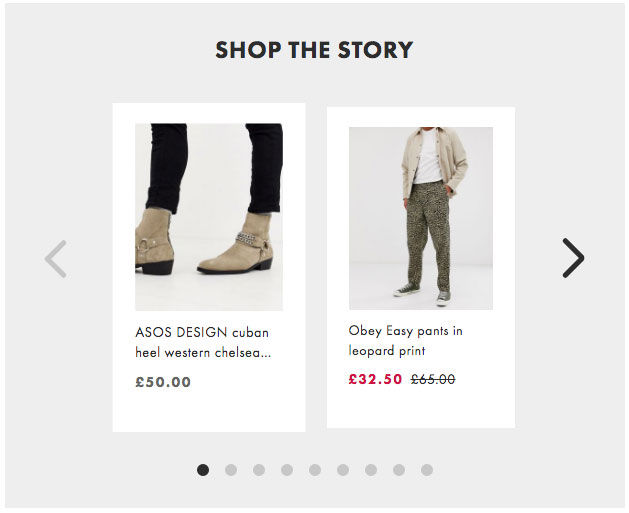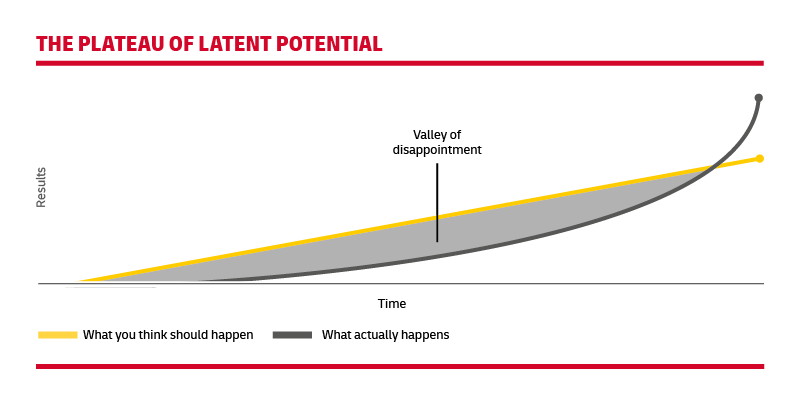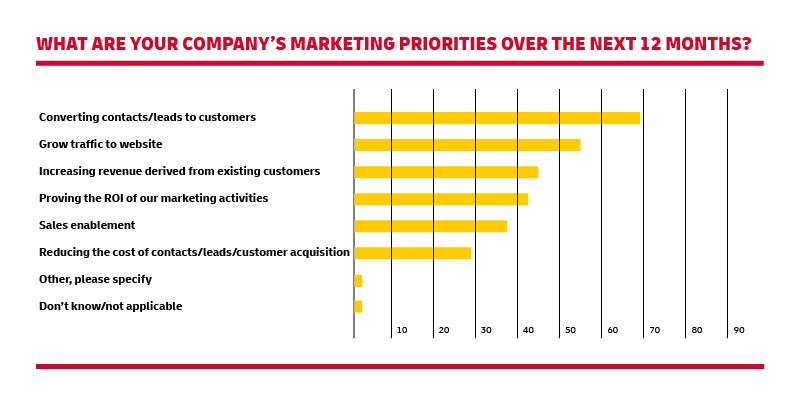Blogging is a critical part of any marketing strategy regardless of your type of business, however, e-commerce companies have so many other critical tasks on their plate that they often overlook the potential impact high-quality content can have on their brand.
According to HubSpot1, marketers who prioritize blogging are 13x more likely to achieve a positive return on their investment—meaning that companies who invest in regular blog content are dramatically more likely to translate their marketing efforts into revenue.
That figure alone should be enough to catch your attention and ask whether or not your e-commerce brand should be investing in blogging as a customer acquisition channel.
But remember this: There’s a big difference between hiring a couple of freelance writers to haphazardly write a few blog posts each week, send an email to your marketing list and hope for the best—versus creating strategic blog content that will benefit your e-commerce business by way of driving highly qualified traffic, increasing customer engagement and generating sales.
If you invest in blogging for e-commerce the right way, then real results will follow. If you don’t approach this marketing channel with the right goals and mentality, it’s easy to spend your time, money and energy creating the wrong content that won’t perform over the long-term.
The Real Benefits of Blogging for E-commerce Brands
Every e-commerce brand has one thing in common: they have competition.
Therefore, it’s crucial to find ways you can set your brand apart from others in your space. And blogging allows you to do just that.
Your blog is your voice to the outside world. It’s a place to share general news about your industry, highlight updates on your products, tease new product images, take a stand for a cause you’re committed to and so much more.
Here are the biggest benefits of using blogging as part of your e-commerce marketing strategy.
1. Show a Human Side to Your Brand
As we’ve mentioned already, your blog is truly a direct voice for your brand to reach the outside world. This is an extremely powerful tool for an e-commerce brand, as most customers (and prospective customers) often see online brands as nothing more than the products they sell.
While showing a human side, you can simultaneously establish authority in your space.
Authority means something different to everyone, but in the context of blogging for e-commerce, building the authority of your brand is all about:
- Proving your knowledge to your audience
- Sharing answers to common questions they have
- Addressing common concerns (which can help increase conversions)
- Providing in-depth, easily digestible content that entertains and educates
- Aligning your brand with key influencers in your space
Take for example NET-A-PORTER2, a wildly popular e-commerce company that’s well-known for selling products from the world’s most coveted designer brands.
To establish their industry authority, the NET-A-PORTER blog regularly shares content that’s created through collaborations with recognizable celebrities and fashion icons, such as this recent cover story with award-winning actress Claire Danes3.
While this interview-based article starts off as an editorial introduction to the personal life of Homeland actress Claire Danes, it also does a great job of tastefully weaving in elements of her personal style and fashion choices—two things that NET-A-PORTER knows their readers care deeply about.
You will also see a prominent series of original photos taken with clothing items that are for sale on NET-A-PORTER mixed in throughout the article, with a clear call-to-action, “Shop the Look” that allows you to quickly add any of the items worn by Danes directly into your own shopping bag.
This e-commerce brand has mastered the marriage of editorial blog content with product placements as a seamless channel to help drive incremental sales and convert new readers into email subscribers (prospective future customers) to build a closer relationship with.
Note: Be sure to properly label any advertorial content (that is, an advertisement presented in the form of editorial content) or explicitly state when you’re showing placements of your own product advertisements throughout your blog content, if you decide to develop a close connection between your blog and e-commerce store.
2. More Traffic to Your Website
Traffic, traffic, traffic. The more you get, the greater chance there is to boost your store’s revenue.
But before you can drive traffic to your e-commerce store, you need a plan for making it happen. Generally speaking, your options as an e-commerce brand include marketing strategies like: blogging, search engine optimization, organic & paid social media and pay per click (PPC) campaigns on a variety of different platforms.
Each of these could be argued as deserving of a fair share of resources depending upon the size of your business, but the right blog marketing strategy could make the difference between achieving average results and creating a foundation for outperforming your revenue goals far into the future.
Here’s what you get when you blog:
A consistent blogging strategy has the potential to drive more traffic to your website over the weeks, months and years to come.
With more visitors frequenting your site, you will find ways to creatively showcase your products, contextually weave them into your overall strategy and encourage more movement to your store—all of which make it easier to reach your primary marketing goals.
3. Convert Readers into Customers
It’s one thing to generate traffic to your website, but another activity entirely to succeed at converting those consumers into paying customers.
Every page of your website (and blog) should be designed with the user experience4 in mind. When it comes to blogging for e-commerce, that means creating and presenting content that’s not only genuinely helpful to the reader, but also has the potential to convert them into buyers.
Sticking with NET-A-PORTER as a phenomenal example of conversion-oriented content in action, here’s a blog post that’s very intentionally designed to convert their readers into buyers:
Take notice of these factors:
- The attention-grabbing headline
- The mix of content and product images
- The engaging, informative nature of the content
- The ability to “add to shopping bag” with one click
After reading through these product reviews, getting very clear use cases and seeing high quality photos, readers have all the information they need to decide if one or more of these products are right for them.
Not every blog post will hit this hard in regards to being optimized for immediate sales, but it’s a content format that should be used within your blog marketing strategy as an e-commerce business.
4. Engage Your Audience
You can use your e-commerce blog in many different ways. From educating to selling, there’s no shortage of options to start meaningful conversations and learn more about both your existing customers and those considering their first purchase.
With each blog post you publish, you have the opportunity to engage with your audience in ways that simply can’t be done through any other marketing channel. Try this:
Another win-win way to engage your audience that we’ve touched on a bit already, is to give them the opportunity to purchase the products you’ve mentioned within your blog posts—and there are many different ways to successfully do that.
The fashion e-commerce giant, ASOS, does a great job of this, with a widget like the one pictured below, placed at the end of all their blog content to help drive their readers over to relevant product pages where they can shop for the fashion items they’re seeing in the company’s blog posts:
Remember that it’s not good enough just to attract readers to your new content—that’s not a true blog marketing strategy. It’s your job to thoughtfully engage those readers at every turn of their experience with your website.
Even if the readers of your blog content don’t make a purchase right away, a high level of engagement increases the odds of them wanting to sign up for your email list to get new product updates, to think of your brand first for a particular product category and to return in the future.
5. Blogging is a Long-Term Marketing Strategy
Let’s face it, some of the marketing decisions you will make in your e-commerce business are naturally short-sighted. There’s nothing wrong with looking for quick wins, as opposed to investing in long-term projects that won’t realize a return for many months into the future.
While blogging can generate immediate revenue—especially if you’ve built a strong and loyal audience that just needs the right nudge to come back for a repeat purchase—this marketing channel is particularly unique in the way that it can generate massive long-term results, while traction in the short-term feels a little sluggish as you’re just getting started.
This phenomenon is known as the plateau of latent potential5, which describes the natural expectation of seeing noticeable progress at the very beginning of your journey, yet we rarely do. The ensuing valley of disappointment most people (and businesses) go through, shows up prominently when launching a new blog marketing strategy—so you need to plan accordingly.
Take for example a hypothetical e-commerce brand that sells designer shoes. Maybe you will publish a blog post in January titled, “The 50 Best Designer Shoes of 2020.”
At first, you won’t get much traffic to the article—unless you have a sizable audience to drive into that post from either your email list, social channels or by activating influencers in your space. In all likelihood, it’s just the people who organically discover your post by visiting your website and clicking around, or seeing a friend who’s shared about the article on social media.
However, since this post is designed to be a long-form authority guide that provides real value to your audience, it will begin to pick up steam with search engines that are striving to surface high-quality recommendation collections for users with these types of queries. So, with some steady social sharing and influencer outreach through April or May, this article is now starting to rank on the first page of search results for keywords like “best designer shoes” and “best designer shoes 2020,” thus sending you a few hundred new readers and a couple of sales every single day.
In this fictional example, it took four months to start reaping the rewards of your labor, but you now have an asset that will continue to send traffic to your website for many months (hopefully years) to come. The success of this single article will also serve to boost your site’s credibility in the eyes of search engines, making it easier to quickly rank for tangentially related keywords moving forward.
The key is to remember that a blog marketing strategy is a long-term endeavor. You build momentum with every new post you publish, so it requires the ability to keep releasing high-quality content over the course of the months to come.
There’s an undeniable snowball effect that will eventually lead to great results—if you stick with it.
3 Key Types of Blog Posts for Every E-commerce Business
It’s a common concern amongst bloggers in all types of businesses—not just those in the e-commerce space—that you will start out with the best of intentions and a long list of topics to write about, but you will one day find yourself running short on actionable blog post ideas.
There are many types of posts you can publish on your e-commerce blog though, with these three amongst the most common and effective:
1. The Product Post
It doesn’t matter if you focus these types of blog posts around one product or several, the goal is simple—to showcase your products in a favorable light, highlight their benefits, show them in-use out in the real world and to generate attention.
The NET-A-PORTER blog regularly employs this type of post. Here’s a recent example:
In addition to their editorial team crafting an engaging headline and using an eye-catching featured image, the content in this product-focused blog post is concise, direct and full of suggestions for fashionable coats to pick up for this winter season.
And speaking of suggestions, here’s the direct (dynamic) product selection widget you will see placed at the bottom of the article to encourage a related purchase:
With this kind of blog post format, if readers are intrigued by the product you’re showcasing in the content, they will have several hand-picked options at the end of the article to consider purchasing or at the very least, learn more about.
2. The Informative Post
In a smart blog marketing strategy for e-commerce, not every post should be created with the primary goal of making a sale—that’d quickly exhaust your audience and give them the impression you’re being strictly transactional with your content.
Some blog posts are meant to inform readers by sharing information regarding:
- New product launches and service offerings
- Company updates
- Community-related news (events, meetups, customer stories)
This type of content is much more about forging a long-term, trusted relationship with your audience and is less about making a sale—but nevertheless it’s an important element of a successful content marketing mix.
3. The First-Person Post
A first-person narrative-style article comes across as more like a story than anything else. And for an e-commerce brand, storytelling—whether from your internal team, from customers or otherwise—is hugely beneficial in many ways.
For one, creative storytelling allows you to more naturally sell the benefits of your products through descriptions of how they’re being used out in the real world, rather than a direct sales pitch to your audience.
Beyond that, a first-person narrative also gives members of your team the opportunity to share something that’s important to them. It can show your audience the human side of your brand.
Here’s a great recent example from the Patagonia blog:
This blog post is a first-person account from someone who has direct experience working with Patagonia Action Works, the clothing brand’s initiative that informs people of local activism opportunities around land, water, climate, communities and biodiversity—with the goal that more customers will take action and help preserve the planet.
Clearly, this blog post isn’t meant to sell anything in particular. Rather, it’s shared to inform Patagonia customers about issues the brand advocates for, and create awareness around something that’s important to both the company and their customers.
It’s designed to build stronger customer bonds around a shared cause.
Is that all a first-person post can be used to accomplish, though?
Definitely not.
The great thing about e-commerce blogging, is that you’re creating the opportunity to share almost anything that has the potential to positively impact your business (as long as it makes sense from a brand perspective).
Just a few other actionable ideas include formats like:
- Interviews with customers, vendors and employees
- Commentary on relevant current events
- How-to guides
- Industry news
- Infographics
- Reviews, unboxing videos and tutorials
The content topics—and even the various different formats6—are truly endless.
Experiment with multiple types of formats in your blog marketing strategy to better understand what clicks best with your audience and what drives the most results in terms of traffic & sales.
Don’t Have a Blog Yet? Fear Not, Here Are the Basics
Even if you don’t have a blog set up for your e-commerce business yet, you will be able to get one off the ground in a matter of minutes—and expect to start seeing measurable results in the weeks and months to come.
Thanks to a variety of extremely easy-to-use tools and platforms, it’s now faster than ever to start a blog from a technical perspective.
However, the actual steps you take to create a blog will depend largely on factors such as:
- The platform your website (e-commerce store) is running on
- Your preferences in regards to which content management system7 to use
- How much technical knowledge you or your team have today
If you want a more in-depth, step-by-step tutorial to follow, check out this ultimate guide about how to start a blog. For now though, we’re going to simplify the process by outlining three key steps you must take first in order to launch a blog:
There are plenty of additional steps you will end up taking on the road to perfecting your e-commerce blog, but these basics will set you down the right path.
Once your blog is set up, it’s time for the fun stuff—populating it with valuable content.
What to Include in Your Blog Marketing Strategy
Wouldn’t it be great if you could just publish a few blog posts, wait for them to start ranking on all of your most important search engine keyword phrases and begin reaping the rewards?
While high-quality content and patience are critical to any blog marketing strategy, it’s the active marketing component that will make or break the true success of your in the long run.
When devising a blog marketing strategy, you will need to approach the activity with both your short and long-term goals in mind. According to HubSpot research9, marketers actually have a variety of different priorities (and goals):
Once you know the goals you want to achieve with content, turn your attention to the following:
Define your target audience: Before you ever start writing, it’s critical to define who your target audience is. It’s safe to assume you’re targeting people who are interested in buying your products, but strive to dig deeper than that. Where do they live? What’s their age range? What are their other interests? Where do they hang out online? Drill down until you’ve created a buyer persona10 that can guide your content creation efforts.
Create a content calendar: This is where documenting all of the work you’ve done up to this point will come in handy. Your content calendar outlines the type of content you will publish, who will create it and most importantly—the topics you will cover. Don’t take for granted just how powerful a content calendar can be in terms of keeping your workflow organized and on track with target publishing dates. It will also help prevent the accidental duplication of content11 in the future.
Choose key performance indicators (KPIs): Don’t assume that your blog marketing strategy is working, just because you’ve seen an influx of readers coming to your new content. Instead, choose specific KPIs that will allow you to track your progress against the measurable goals that stand to have a real impact on the growth of your business. Generally speaking, the most important KPIs here will be based on traffic, engagement, email subscribers, sales and attributable revenue.
Once you do these three things well, you will have a solid blog marketing strategy in place that will allow you to hit the ground running with your content efforts.
From here, it’s all about tracking your performance, tweaking your plan along the way, experimenting with new traffic sources and conversion optimizing your content that has the greatest chance of translating into direct product purchases.
Helpful Tools for E-commerce Blogging Success
When it comes to blogging, there’s a tool for almost everything out there.
Many of these tools are free and some are paid, but regardless of your marketing budget, you should be able to find several useful blogging-related tools that fit into your plans and provide you with a helpful service that amplifies your results.
Since there are quite literally thousands of different blogging-related tools to choose from, it’s important to do your own research to find those that best align with your strategy and goals. But for now, here’s a breakdown of the best tools in several important categories:

Google Analytics
In addition to being free, Google Analytics is the most popular way for brands to track website traffic—and if you already have an e-commerce site live today, the odds are that you probably already have Google Analytics installed. It provides access to data such as users, sessions, page views, bounce rate and so much more.

Competitor and Keyword Research: Ahrefs
Ahrefs is hands down the most useful tool suite in a digital marketer’s arsenal today. With a long list of functions and features that will help you do everything from keyword research, to gathering actionable ideas on how to boost your own traffic, observe how a competitor’s website is performing and everything in-between, it will be an indispensable part of your blog marketing strategy. Ahrefs can help you answer incredibly insightful questions like: Which topics are your competitors blogging about (and why)? How much search volume is there for a particular keyword phrase? Where is my competitor’s traffic coming from? Why does their content ranks higher than yours?

Content Creation Insights: Clearscope
With an AI-powered platform, Clearscope helps you get more out of every piece of content you publish. It was built on the premise that great content isn’t always enough to reach the top of search engines—and that your content also needs to be highly relevant in order to outperform everything else in your industry.

Topic Selection: BuzzSumo
Even if you have an idea about what you want to cover for an upcoming article, choosing the exact right topic and corresponding headline that’s going to resonate with your target audience, is easier said than done. But BuzzSumo can help. All you have to do is enter your keyword phrase and let the tool get to work. It generates a comprehensive list of the most popular blog posts on the Internet for your keyword phrase, thus giving you a clear sense of what’s working best and what readers will likely be expecting.

Social Media Sharing: Hootsuite
Once you’re ready to share your blog content on the social media channels your audience spends time on, you won’t want to spend tons of time manually publishing every tweet, Facebook post or Pinterest image throughout your day. Hootsuite is a leading social media management platform that allows you to schedule content in advance and monitor each of your channels in one dashboard. This ensures that your blog content is shared in all the right places, at the right times.

Business Performance Metrics: Dasheroo
You’ve set your KPIs, but you will also need a system for tracking them. Dasheroo is a free business dashboard for tracking your key benchmarks—as reported from the metrics you’re collecting from other tools like Twitter, Facebook, YouTube, Google Analytics, Salesforce and many more
Final Thoughts on Blogging for E-commerce
If you want to build your e-commerce brand and you’re invested for the long-haul, blogging can be one of the most impactful strategies to focus on this year. Before you start churning out content though, it pays dividends to develop a true blog marketing strategy (like we’ve broken down here today). As a reminder, here are the action steps you should take in order to set your e-commerce blog down the path to success:
Design and launch your blog
Set clear goals
Create a content calendar (and share it with all applicable parties)
Create an e-commerce blogging strategy that fit your brand and budget
Implement the right tools to improve efficiency and boost performance
When you do all of these things well, you will find yourself in a position to create relevant content that ranks in the search engines, attracts (and engages) your target audience—and converts more of your readers into paying customers.
Ryan Robinson is a blogger, podcaster and side project aficionado who teaches 500,000 monthly readers how to start a blog and grow a profitable side business at ryrob.com.
1 Hubspot
3 Claire Danes, Woman of Action, Net-a-Porter, Feb 2020
4 What is User Experience (UX) Design? Interaction Design Foundation
5 Overcoming the Trough of Sorrow, Four Pillar Freedom
6 105 Types of content to fill up your editorial calendar, Convince & Convert
7 Content management system definition, Wikipedia
8 8 Web design principles to know, CXL.com
9 State of Marketing, Hubspot
10 How to create a buyer persona in 5 simple steps, AWeber
11 Duplicate content, Moz.com


























































